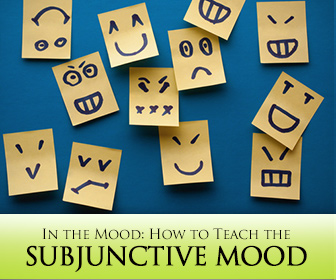Not in the mood to teach the subjunctive mood?
The subjunctive is used when expressing a command, a suggestion or a wish. Although this is not exclusively so, the subjunctive is most often used with subordinate clauses that begin with that: I suggest that you buy a new car; I recommend that you see a doctor, etc… There is more than one way to teach the subjunctive, but there is one way that could potentially be less confusing – and more fun for your class. So, here’s what I suggest you do:

How to Teach the Subjunctive Mood (with Subordinate Clauses)
-
1
Ask for Recommendations
Tell your class that you need to plan a weekend trip to a nearby town. Ask them for suggestions/recommendations on different aspects of the planning such as transportation, hotel reservations, what to pack, etc… Review, if needed, that suggest and recommend are verbs that are followed by a gerund. Write their ideas down on the board. So, some of their suggestions might sound like these:
I suggest booking a room a few weeks in advance.
I recommend staying near the beach.
I suggest packing some sunblock.
I recommend being careful in the ocean.
Etc… -
2
Introduce the Subjunctive
Ask one of your students to ask you for a recommendation now. Let’s suppose he/she asks you which form of transportation to take to a particular location. Look at your class and say: Juan wants to know which form of transportation to take. Write on the board and say: I suggest that he take the train.
Have students look closely at the previous list of recommendations and compare them to this new form. Students should point out the use of that. They should also notice the form of the verb take. It has no s; it’s not in third person singular form. Explain to the class that because you are using a that clause after the verb suggest, the verb has to be in the subjunctive. This is the same for any person or pronoun, singular or plural – you are basically using the verb in its base form – point out a sentence with be, for example: I suggest you be early.
-
3
Ask for More Examples
Now, have students re-phrase their previous suggestions by using a that clause; tell them it also works for the verb recommend.
I suggest that you book a room a few weeks in advance.
I recommend that you stay near the beach.
I suggest that you pack some sunblock.
I recommend that you be careful in the ocean.
Etc… -
4
Point out More Basics
After coming up the previous sentences students should understand that the subjunctive is just like the present simple form, except:
- In the verb to be
- In the third person singular (I suggest he take, not takes)
Also, point out that the subjunctive sounds more formal than other ways of suggesting/recommending. Brainstorm situations in which they might want to use the subjunctive: in formal business meetings, when talking to clients or in any professional role.
Finally, point out the fact that the use of that is optional: I suggest you buy your ticket in advance.
-
5
Give Them More Verbs to Use
The subjunctive not only works with suggest and recommend. Give them a list of verbs: insist, request, urge, demand, advise, ask, just to name the most common. Ask your class some questions to practice these: Does your boss insist that you work on weekends? Next, try some questions from students.
-
6
Teach the Subjunctive after Some Adjectives
Write these adjectives on the board: important, best, imperative, essential, necessary and crucial. Tell them that these adjectives may also be followed by the subjunctive when you are giving recommendations, indications or even commands. Provide some examples: It is essential that you pack sunblock for your trip.
-
7
Practice Time!
Make this first real practice exercise more controlled; you may choose to either continue with the question and answer mode or give them a worksheet to complete. Correct mistakes as needed, and make sure they are using the subjunctive correctly with both the verbs and the adjectives.
-
8
Put it All Together!
Now is the time to put everything they’ve learned about the subjunctive to good use. Prepare some simple cards with situations in which someone might need a suggestion: new in town, an illness, trying to improve their pronunciation, etc...Divide your class into pairs. Each student takes a card. Student A presents his/her situation: I want to improve my English, What do you suggest I do? Student B provides suggestions, then they switch. After all the pairs are done, students share the recommendations they obtained: Sarah suggested I watch more movies in English.
And presto! With enough practice, your students should have the subjunctive mood down pat.
Students will find it especially useful in job situations – and they’ll speak like real pros, too!
P.S. If you enjoyed this article, please help spread it by clicking one of those sharing buttons below. And if you are interested in more, you should follow our Facebook page where we share more about creative, non-boring ways to teach English.







